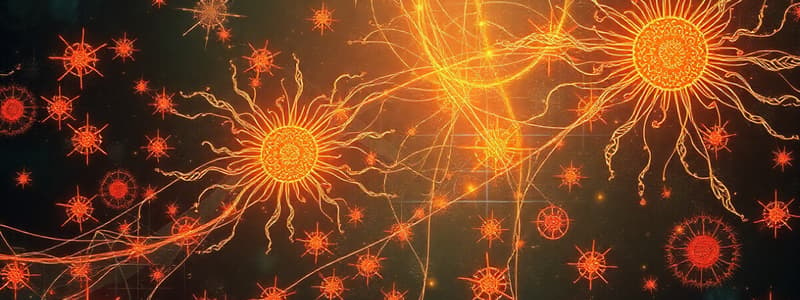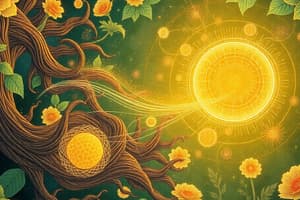Podcast
Questions and Answers
Which of the following statements best describes the first law of thermodynamics?
Which of the following statements best describes the first law of thermodynamics?
- Energy can be destroyed but not created.
- Energy can be created but not destroyed.
- Energy cannot be created or destroyed, but it can be changed from one form to another. (correct)
- Energy transformations are 100% efficient.
What is the ultimate fate of energy transformation according to the second law of thermodynamics?
What is the ultimate fate of energy transformation according to the second law of thermodynamics?
- All energy is converted into potential energy.
- Energy is completely recycled with no loss.
- The universe becomes more organized.
- The universe becomes less organized due to the increase in entropy. (correct)
Why is glucose considered more organized compared to its breakdown products, carbon dioxide and water?
Why is glucose considered more organized compared to its breakdown products, carbon dioxide and water?
- It is more stable.
- Its atoms are arranged in a complex structure. (correct)
- It has less potential energy.
- It contains fewer atoms.
The synthesis of glucose from carbon dioxide and water during photosynthesis is energized by:
The synthesis of glucose from carbon dioxide and water during photosynthesis is energized by:
What term describes the sum of all chemical reactions that occur within a cell?
What term describes the sum of all chemical reactions that occur within a cell?
Which statement accurately describes an exergonic reaction?
Which statement accurately describes an exergonic reaction?
How does ATP provide energy to drive endergonic reactions in a cell?
How does ATP provide energy to drive endergonic reactions in a cell?
What primarily determines whether a series of linked reactions is defined as a metabolic pathway?
What primarily determines whether a series of linked reactions is defined as a metabolic pathway?
If Enzyme 1 (E1) in the pathway A → B → C → D → E → F → G is non-functional, what is the most likely outcome?
If Enzyme 1 (E1) in the pathway A → B → C → D → E → F → G is non-functional, what is the most likely outcome?
Which of the following occurs when an enzyme binds to its substrate?
Which of the following occurs when an enzyme binds to its substrate?
How do enzymes speed up biochemical reactions?
How do enzymes speed up biochemical reactions?
A reaction is proceeding very slowly. If you add more substrate, the reaction rate increases. What is most likely the limiting factor?
A reaction is proceeding very slowly. If you add more substrate, the reaction rate increases. What is most likely the limiting factor?
How would a significant change in pH affect the rate of an enzyme-catalyzed reaction?
How would a significant change in pH affect the rate of an enzyme-catalyzed reaction?
What role do FAD, NAD+, and NADP+ play in cellular processes such as respiration and photosynthesis?
What role do FAD, NAD+, and NADP+ play in cellular processes such as respiration and photosynthesis?
If a substance binds to an enzyme at a location away from the active site and decreases its activity, what type of inhibition is this?
If a substance binds to an enzyme at a location away from the active site and decreases its activity, what type of inhibition is this?
What is the primary difference between oxidation and reduction reactions?
What is the primary difference between oxidation and reduction reactions?
In the production of NaCl, sodium is oxidized and chlorine is reduced. Therefore:
In the production of NaCl, sodium is oxidized and chlorine is reduced. Therefore:
In photosynthesis, which molecule is oxidized and which is reduced?
In photosynthesis, which molecule is oxidized and which is reduced?
During cellular respiration, what happens to glucose?
During cellular respiration, what happens to glucose?
Which of the following statements about the relationship between endothermic animals and temperature is MOST accurate?
Which of the following statements about the relationship between endothermic animals and temperature is MOST accurate?
What is the MOST accurate statement about the role of active sites in enzymes:
What is the MOST accurate statement about the role of active sites in enzymes:
What is the most accurate statement about the role of ATP in cells?
What is the most accurate statement about the role of ATP in cells?
What is the correct statement about what happens to entropy in cells?
What is the correct statement about what happens to entropy in cells?
Which of the following provides a correct statement regarding enzymes?
Which of the following provides a correct statement regarding enzymes?
What happens when living cells that depend on a constant supply of solar energy don't receive it?
What happens when living cells that depend on a constant supply of solar energy don't receive it?
What happens if a moose walks?
What happens if a moose walks?
What is the BEST definition of energy?
What is the BEST definition of energy?
What is the best definition of potential energy?
What is the best definition of potential energy?
What is the best definition of kinetic energy?
What is the best definition of kinetic energy?
What is the correct statement regarding metabolic pathways?
What is the correct statement regarding metabolic pathways?
Which of the following statements regarding enzymes is MOST accurate?
Which of the following statements regarding enzymes is MOST accurate?
What happens during the degradation process?
What happens during the degradation process?
What process does the reduction of carbon dioxide entail?
What process does the reduction of carbon dioxide entail?
Flashcards
What is energy?
What is energy?
The ability to do work or bring about a change.
What is kinetic energy?
What is kinetic energy?
Energy of motion. Examples include mechanical (water over a waterfall).
What is potential energy?
What is potential energy?
Stored energy. Examples include chemical energy in food.
What is the Law of Conservation of Energy?
What is the Law of Conservation of Energy?
Signup and view all the flashcards
What is the Law of Entropy?
What is the Law of Entropy?
Signup and view all the flashcards
What is metabolism?
What is metabolism?
Signup and view all the flashcards
What is free energy (delta G)?
What is free energy (delta G)?
Signup and view all the flashcards
What are exergonic reactions?
What are exergonic reactions?
Signup and view all the flashcards
What are endergonic reactions?
What are endergonic reactions?
Signup and view all the flashcards
What is ATP?
What is ATP?
Signup and view all the flashcards
What is the role of ATP in cells?
What is the role of ATP in cells?
Signup and view all the flashcards
What is a metabolic pathway?
What is a metabolic pathway?
Signup and view all the flashcards
What are enzymes?
What are enzymes?
Signup and view all the flashcards
What are substrates?
What are substrates?
Signup and view all the flashcards
What is the active site?
What is the active site?
Signup and view all the flashcards
What is the induced fit model?
What is the induced fit model?
Signup and view all the flashcards
What is energy of activation?
What is energy of activation?
Signup and view all the flashcards
What factors affect enzymatic rate?
What factors affect enzymatic rate?
Signup and view all the flashcards
What are cofactors?
What are cofactors?
Signup and view all the flashcards
What are coenzymes?
What are coenzymes?
Signup and view all the flashcards
What is competitive inhibition?
What is competitive inhibition?
Signup and view all the flashcards
What is noncompetitive inhibition?
What is noncompetitive inhibition?
Signup and view all the flashcards
What is oxidation?
What is oxidation?
Signup and view all the flashcards
What is reduction?
What is reduction?
Signup and view all the flashcards
What is OILRIG?
What is OILRIG?
Signup and view all the flashcards
What is the photosynthesis equation?
What is the photosynthesis equation?
Signup and view all the flashcards
What is the cellular respiration equation?
What is the cellular respiration equation?
Signup and view all the flashcards
Study Notes
Cells and Energy Flow
- Energy is the capacity to perform work or cause alterations.
- Kinetic energy is energy of motion, like water moving over a waterfall.
- Potential energy is stored energy, such as chemical energy found in food.
- Energy flows, it doesn't cycle.
Laws of Thermodynamics
- Energy Law of Conservation: Energy can change form but cannot be created or destroyed, such as in photosynthesis.
- The Law of Entropy: Energy transformation is never 100% efficient, and usable energy is lost.
- Energy transformation makes the universe less organized, with disorder increasing.
- Producers use energy to generate organized structures in biological molecules.
- Organisms depend on solar energy for survival.
Cells and Entropy
- Cellular processes transform energy and increase entropy in the universe.
- Increased entropy reduces available energy for work.
- Glucose tends to degrade into carbon dioxide and water.
- Glucose is more organized but less stable than its breakdown products.
- Energy from photosynthesis (sun) is used to create glucose from carbon dioxide and water.
Metabolism and Energy Transformations
- Metabolism is the compilation of chemical reactions that occur in a cell.
- Free energy (delta G) is the amount of energy remaining to execute work post-chemical reaction.
- Exergonic Reactions have a negative delta G (< 0), are spontaneous, release energy, and have less free energy in the products than reactants.
- Endergonic Reactions have a positive delta G (> 0), are non-spontaneous, require energy, and have more free energy in the products than reactants.
ATP: Energy Currency
- ATP is an unstable molecule with high potential energy.
- ATP is a nucleotide composed of adenine, ribose sugar (adenosine), and three phosphate groups.
- ATP supplies energy for:
- Chemical work: synthesizing macromolecules
- Transport work: pumping substances across membranes
- Mechanical work: muscle contraction, movement of cilia and flagella.
- ATP is not stored in cells.
- ATP captures energy from exergonic reactions.
- ATP acts as a chemical energy carrier for endergonic reactions.
- Cells can couple ATP hydrolysis to energy-requiring reactions in two ways:
- ATP energizes a reactant.
- ATP changes the shape of a reactant.
- The hydrolysis of ATP releases stored energy, which allows changes in the amount of free energy to complete work.
- Hydrolysis of ATP has negative delta G.
- Examples of ATP hydrolysis: protein synthesis, nerve conduction, and muscle contraction
Metabolic Pathways and Enzymes
- Reactions typically occur in a sequence.
- A Metabolic pathway is a series of linked reactions.
- A metabolic pathway
- Begins with a specific reactant, proceeds through intermediates, and ends with a specific end product.
- A = Initial Reactant/Substrate
- B, C, D, E, and F = Intermediates
- G = End Product.
- Enzymes are protein catalysts.
- Substrates are reactants in an enzymatically catalyzed reaction.
- Each enzyme accelerates a specific reaction.
- Each reaction in a metabolic pathway needs a unique, specific enzyme.
- The end product will not form unless all pathway enzymes are present and functional.
- Active site is the part of an enzyme that is complexes with substrate.
- An active site causes enzymes to change shapes.
- In the Induced fit Model, the enzyme changes shape slightly to fit the substrate.
- After the reaction is complete, the product is released and the enzyme returns to its original shape.
- Energy of Activation is the added energy needed for molecules to react together.
- EA prevents spontaneous molecule degradation within the cell.
- Enzymes lower the energy of activation by bringing the substrates into contact, speeding up reactions.
Factors Affecting Enzymatic Rate
- Substrate Concentration: Increased substrate concentration increases enzyme activity due to frequent collisions between substrate molecules and the enzyme.
- Temperature:
- Increased temperature increases enzyme activity.
- Warmer temperatures cause more effective collisions between enzyme and substrate.
- High temperatures can denature and destroy enzymes.
- pH:
- Enzymes have an optimal pH for reaction rate.
- pH changes alter enzyme shapes and reduce enzymatic speed.
- Extreme pHs denature enzymes.
- Enzyme Cofactors are molecules required to activate enzymes.
- FAD, NAD⁺, and NADP⁺ are cofactors involved in cellular respiration and photosynthesis.
- Coenzymes are nonprotein organic molecules.
- Vitamins are organic compounds for coenzyme synthesis.
- Enzyme Inhibition: Inhibitors decrease enzyme activity.
- Competitive inhibition involves the substrate and inhibitor competing for the active site.
- Noncompetitive inhibition involves the inhibitor binding to an allosteric site, not the active site.
Oxidation-Reduction (Redox) Reactions
- Electrons transfer from one molecule to another.
- Oxidation – loss of an electron
- Reduction – gain of an electron
- Oxidation and reduction occur simultaneously.
- One molecule (or atom) accepts the electron given up by the other.
- Example: Sodium is oxidized and chlorine is reduced to produce NaCl.
- OILRIG = oxidation is loss, reduction is gain.
Photosynthesis and Cellular Respiration
- Photosynthesis: 6CO₂ + 6H₂O + energy → C₆H₁₂O₆ + 6O₂. Carbon dioxide is reduced and water is oxidized.
- Cellular Respiration: C₆H₁₂O₆ + 6O₂ → 6CO₂ + 6H₂O + energy. Glucose is oxidized, and oxygen is reduced.
- Chloroplasts capture solar energy to convert water and carbon dioxide into carbohydrates.
- Hydrogen atoms are transferred from water to carbon dioxide as glucose forms.
- The reduction of carbon dioxide to form glucose stores 686 kilocalories of energy.
- Photosynthesis involves the coenzyme NADP⁺: NADP⁺ + 2e⁻ + H⁺ → NADPH.
- Mitochondria oxidize carbohydrates and use the released energy to build ATP.
- Cellular respiration consumes oxygen and produces carbon dioxide.
- Glucose is oxidized, and oxygen is reduced in cellular respiration.
- When oxygen gains hydrogen atoms, water is created.
- Cells oxidize glucose stepwise, and create energy.
- Cellular respiration involves the coenzyme NAD⁺: NAD⁺ + 2e⁻ + H⁺ → NADH.
Studying That Suits You
Use AI to generate personalized quizzes and flashcards to suit your learning preferences.




